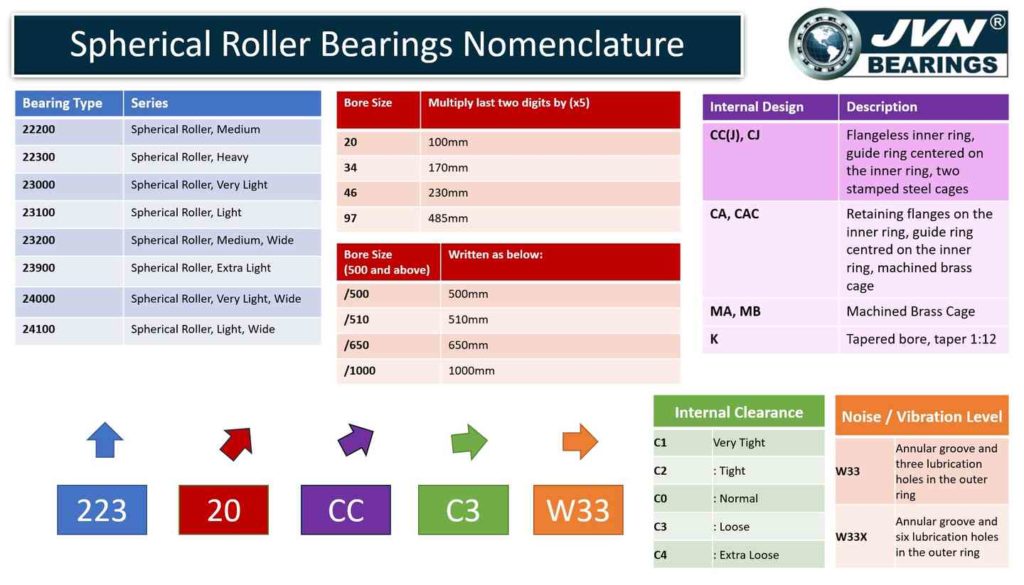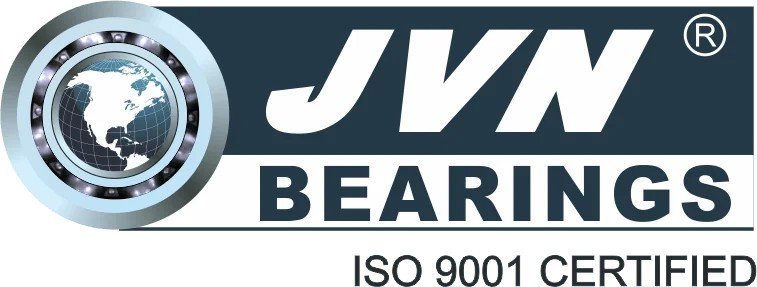JVN BEARINGS
Shop No F6, 1st Floor,
Ruby Commercial Centre,
Pumpwell, Mangalore, Karnataka.
+91- 8244052261
Overview of Spherical Roller Bearings
Spherical roller bearings are rolling-element bearings that permit rotation with low friction and permits angular misalignment. These bearings support a rotating shaft in the bore of the inner ring that may be misaligned in respect to the outer ring. The misalignment is possible due to the spherical internal shape of the outer ring and spherical rollers. Despite their name, spherical roller bearings are not truly spherical in shape. The rolling elements of spherical roller bearings are mainly cylindrical in shape, but have a profile that makes them appear like cylinders that have been slightly over-inflated. The spherical roller bearing was invented by engineer Arvid Palmgren his design is still in use in modern machines.
How do Spherical Roller Bearings Work?
All spherical roller bearings have the same working principal. They all have outer rings that with concave (spherical) inner raceways. The inner rings similarly have convex outer raceways (or rolling elements that create a matching convex sliding surface). What separates the various types of spherical bearings is the design of their sliding surface. Some are ring-to-ring (such as spherical plain bearings and rod ends), others use rolling elements such as balls or rollers between the inner and outer rings.
Applications of Spherical Roller Bearings
- Gearboxes, Drive Shafts
- Wind Turbines,
- Continuous Casting Machines,
- Pumps,
- Mechanical Fans and Air-Blowers,
- Mining and Construction Equipment,
- Textile Manufacturing
- Wood Working Machinery
- Overhead Crane Moving Wheel
- Pulp and Paper Processing Equipment,
- Marine Propulsion
- Offshore Drilling,
- Off-road vehicles.
Types of Spherical Roller Bearings
- Spherical Roller Bearings: They are designed to work in applications where severe misalignment exists. This maybe due to mounting error or shaft deflection. They deal with relatively heavy radial loads and some axial loads in either direction. They are also extremely resistant to shock loads and their self-aligning feature allows full capacity loading despite shaft deflection. They are very similar in purpose to Self-Aligning Double Row Ball Bearings, except the Spherical Roller Bearings are designed to be more robust by carry heavier loads but at lower maximum speeds.
- Spherical Plain Bearings: (also known as “Spherical Plane Bearings“) are spherical bearings that have an inner ring with a sphere convex outside surface and an outer ring with a correspondingly sphere, but concave inside surface. Their design makes them particularly suitable for bearing arrangements where alignment movements between shaft and housing have to accommodate, or where oscillating or recurrent tilting movements must be permitted at relatively slow sliding speeds.
- Spherical Rod End Bearings: A type of spherical bearing that consists of an eye-shaped head with integral shank forming a housing and a standard spherical plain bearing, or a spherical plain bearing inner ring. As the name implies, they are used at the end of rods and have either a male or female thread for mounting.
Nomenclature of Spherical Roller Bearings

Factors Influencing Quality of Deep Groove Ball Bearings
- Steel Grade: The steel grade used during manufacturing plays a crucial role in determining the life and durability of the bearing. Some similar steel compositions steel types would be AISI 52100 (USA), 100CR6 (Germany), SUJ2 (Japan) and GCR15 (China). They are used extensively for manufacturing bearings.
- Bearing Components: The quality of rollers, cages/seals (steel or brass cages), lubricant (grease, even anti-rust oil), oil grooves (they tend to weaken the structure of the bearing) play an important role in the making of a great bearing. Many Chinese factories use EN31 rollers to reduce cost which may reduce the life of the bearings.
- Design Conformity: The closer the bearing is to the dimensional accuracy of the bearing design standards the better and longer it would be able to perform.
- Essential Processes: Forging , Annealing, Stress Relieving, Hardening and Tempering must be followed to ensure quality bearings.
- Grinding: The bearing’s inner and outer ring raceways need to be thoroughly ground over many cycles to ensure a smooth surface for the rolling elements. Many Chinese factories skip or reduce the number of grinding cycles to reduce cost and offer bearings at cheaper prices.
- Cleaning: SAE 52100 has excellent hardness and wear resistance. It also exhibits good fatigue life in rolling element bearings. However, the corrosion resistance of chrome steel is poor because of the low chromium content. The surfaces of the bearings must be thoroughly cleaned and protected with a coating of rust inhibitor or oil to stop oxidation. Even slight humidity or moisture exposure entails rusting of the bearing surface.
- Assembly and Bearing Handling: Bearings must be handled with care and consideration. Few factories have automated all the processes involved to reduce human intervention and ensure cleanliness and hygiene. Majority of the factories in China rely on labor for the assembly, handling and packing of the bearings. The labor are usually unskilled and seasonal workers who are not properly trained. This leads to contamination and improper handling of bearings. Well trained and experienced labor are crucial to the success of the bearing factories.
- Management: The attitude of the top management towards strict conformance and quality control is paramount to the quality of the bearings produced. Simply having an ISO certificate which can be ‘purchased’ is not enough. Rigorous discipline and attention to detail is required of bearing factories.
